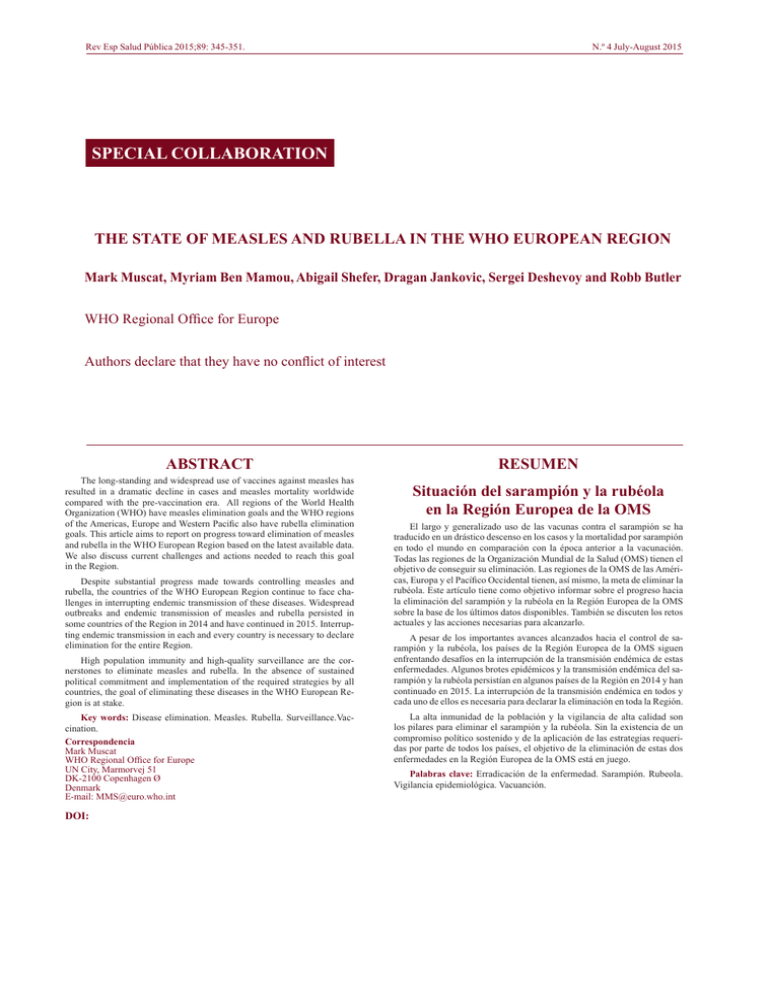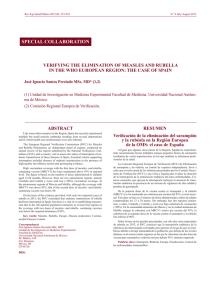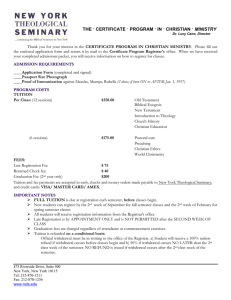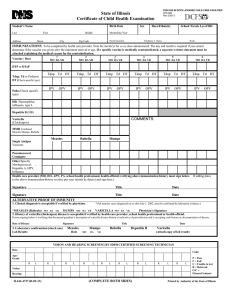the state of measles and rubella in the who european region
Anuncio

Rev Esp Salud Pública 2015;89: 345-351. N.º 4 July-August 2015 SPECIAL COLLABORATION THE STATE OF MEASLES AND RUBELLA IN THE WHO EUROPEAN REGION Mark Muscat, Myriam Ben Mamou, Abigail Shefer, Dragan Jankovic, Sergei Deshevoy and Robb Butler WHO Regional Office for Europe Authors declare that they have no conflict of interest ABSTRACT The long-standing and widespread use of vaccines against measles has resulted in a dramatic decline in cases and measles mortality worldwide compared with the pre-vaccination era. All regions of the World Health Organization (WHO) have measles elimination goals and the WHO regions of the Americas, Europe and Western Pacific also have rubella elimination goals. This article aims to report on progress toward elimination of measles and rubella in the WHO European Region based on the latest available data. We also discuss current challenges and actions needed to reach this goal in the Region. Despite substantial progress made towards controlling measles and rubella, the countries of the WHO European Region continue to face challenges in interrupting endemic transmission of these diseases. Widespread outbreaks and endemic transmission of measles and rubella persisted in some countries of the Region in 2014 and have continued in 2015. Interrupting endemic transmission in each and every country is necessary to declare elimination for the entire Region. High population immunity and high-quality surveillance are the cornerstones to eliminate measles and rubella. In the absence of sustained political commitment and implementation of the required strategies by all countries, the goal of eliminating these diseases in the WHO European Region is at stake. Key words: Disease elimination. Measles. Rubella. Surveillance.Vaccination. Correspondencia Mark Muscat WHO Regional Office for Europe UN City, Marmorvej 51 DK-2100 Copenhagen Ø Denmark E-mail: [email protected] DOI: RESUMEN Situación del sarampión y la rubéola en la Región Europea de la OMS El largo y generalizado uso de las vacunas contra el sarampión se ha traducido en un drástico descenso en los casos y la mortalidad por sarampión en todo el mundo en comparación con la época anterior a la vacunación. Todas las regiones de la Organización Mundial de la Salud (OMS) tienen el objetivo de conseguir su eliminación. Las regiones de la OMS de las Américas, Europa y el Pacífico Occidental tienen, así mismo, la meta de eliminar la rubéola. Este artículo tiene como objetivo informar sobre el progreso hacia la eliminación del sarampión y la rubéola en la Región Europea de la OMS sobre la base de los últimos datos disponibles. También se discuten los retos actuales y las acciones necesarias para alcanzarlo. A pesar de los importantes avances alcanzados hacia el control de sarampión y la rubéola, los países de la Región Europea de la OMS siguen enfrentando desafíos en la interrupción de la transmisión endémica de estas enfermedades. Algunos brotes epidémicos y la transmisión endémica del sarampión y la rubéola persistían en algunos países de la Región en 2014 y han continuado en 2015. La interrupción de la transmisión endémica en todos y cada uno de ellos es necesaria para declarar la eliminación en toda la Región. La alta inmunidad de la población y la vigilancia de alta calidad son los pilares para eliminar el sarampión y la rubéola. Sin la existencia de un compromiso político sostenido y de la aplicación de las estrategias requeridas por parte de todos los países, el objetivo de la eliminación de estas dos enfermedades en la Región Europea de la OMS está en juego. Palabras clave: Erradicación de la enfermedad. Sarampión. Rubeola. Vigilancia epidemiológica. Vacuanción. Mark Muscat et al. BACKGROUND Measles is one of the most contagious human diseases. In the pre-vaccine era, most of the world’s population had measles by late childhood, resulting in an estimated 100 million cases and over 2 million deaths annually.1With the widespread and increased use of the measles vaccine globally there has been a massive decline of cases and measles mortality. Following the availability of vaccines containing both measles and rubella antigens, countries began targeting all children for protection against rubella as well as measles, by recommending the combined vaccine in their routine childhood vaccination programmes. The subsequent widespread use of combined vaccines in the WHO regions of the Americas, Europe and Western Pacific and the consequent dramatic decrease in the number of rubella cases paved the way for these regions to also aim for rubella elimination and the prevention of congenital rubella syndrome (CRS).2-4 Measles and rubella elimination goals have been set by countries of the European Region for 2015. This article describes progress toward global control, and measles and rubella elimination in the WHO European Region in recent years and particularly in 2014. We also discuss current challenges and actions needed to reach this goal in the Region. EPIDEMIOLOGY OF MEASLES AND RUBELLA Global situation of measles in 2014 The Global Vaccine Action Plan5 aims for five WHO regions to eliminate both measles and rubella by 2020. Generally, there has been steady progress toward reducing global measles cases and mortality. During the period 2000–2013, annual reported measles incidence declined 72% worldwide, from 146 to 40 per million inhabitants. The annual es- 346 timated measles deaths declined 75%, from 544,200 to 145,700 with the greatest reduction (88%) in the Western Pacific Region.6 Despite the progress, regions are still facing challenges. Measles outbreaks such as those in Brazil, Canada, Equador and the United States of America threaten measles elimination in the Americas Region. The Western Pacific Region has witnessed a resurgence of disease transmission in China, Papua New Guinea, Philippines and Viet Nam. In the European Region, despite wellestablished immunization programmes and overall high vaccine coverage, some countries have been plagued by low commitment to elimination, poor response to outbreaks, sub-optimal vaccine coverage and growing vaccine hesitancy. Globally, coverage with the first dose of measles-containing vaccine (MCV1) for 2013 was 84%, which is below the coverage required to achieve elimination. For three regions the coverage was above 90% (Americas 92%, Western Pacific 97%, and European 95%) and for the other three regions it was below 80% (South-East Asia 78%, Eastern Mediterranean 78%, and Africa 74%). For the second dose of measles-containing vaccine (MCV2) coverage globally was 56%, with great regional variation. Disease epidemiology in the WHO European Region Measles Based on the latest available monthly reported surveillance data to the WHO Regional Office for Europe, about 50% fewer measles cases were reported for 2014 (n=16,156) (there may be differences in numbers documented in future reports based on data derived from the WHO/UNICEF Joint Reporting Form for 2014) compared with 2013 (n=32,174). The number of cases for 2014 appears to have dropped to the lowest level since 2010 (n=30,604). However, measles transmission continues in 2015 with largeRev Esp Salud Pública 2015. Vol. 89, N.º 4 THE STATE OF MEASLES AND RUBELLA IN THE WHO EUROPEAN REGION Figure 1 Countries that reported the highest incidence (>10 per million inhabitants) of measles in the WHO European Region, 2014 scale outbreaks reported in Bosnia and Herzegovina, Germany, Kyrgyzstan and Serbia.7 The largest number of measles cases in 2014 was reported by the Russian Federation with 3257 cases, and Georgia with 3190 cases. Based on population size, Georgia had the highest incidence of reported measles cases (738 per million inhabitants) followed by Bosnia and Herzegovina (576 per million inhabitants). Figure 1 shows the 12 countries that reported the highest incidence (>10 per million inhabitants) of measles in the Region. Of the regional total in 2014, 8106 (50%) measles cases were laboratory confirmed and 1133 (7%) were epidemiologically linked cases. The remaining 6917 (43%) were classified as clinically compatible cases. Measles occurred in all age groups with 41% of cases in adults aged 20 years and older. However, the age distribution of cases varied greatly by country. Overall, 78% were unvaccinated or with unknown vaccination status. In recent years, measles transmission has been reported in health care facilities and educational institutions.8 Measles, and rubella, outbreaks have also disproportionately Rev Esp Salud Pública 2015. Vol. 89, N.º 4 affected particular groups such as Roma in Poland,9 immigrants in Spain,10 anthroposophic communities in German-speaking countries,11 and orthodox Protestant communities in the Netherlands and Sweden.12-14 Rubella. Rubella continues to be reported by fewer countries than measles, with the majority of cases since 2010 reported by Poland. Although still too high, the number of cases in the Region for 2014 (n=6516) is 84% lower than that reported for 2013 (n=39,554).7 This is primarily due to a decrease in cases reported by Poland − from 38,585 for 2013 to 5899 for 2014 − despite the lack of a response measure to control the outbreak. For 2014, 21 countries reported rubella cases, but Poland reported by far the majority of cases (n=5899), followed by Kazakhstan (n=152), Germany (n=151) and Georgia (n=150).7 Of all rubella cases reported for 2014, only 3% were laboratory confirmed, primarily due to the lack of rubella laboratory testing in Poland, the largest contributor of rubella in the Region. 347 Mark Muscat et al. Laboratory results Serology is still considered the gold standard for case laboratory confirmation.15 For elimination the role of molecular epidemiology based on genotyping through sequencing is also recognized as critical.16 During 2014, 1053 clinical specimens of measles cases were sequenced (as of 25 August 2015) from 34 countries. The sequence data were entered in the Measles Nucleotide Surveillance database (MeaNS)17 by national or reference laboratories of the WHO European Region. The genotypes identified in the Region comprised D8 (n=637), B3 (372), D4 (21), H1 (17), D9 (4) and G3 (2). Variants of the D8 genotype were reported by 28 countries. Twenty-one countries reported genotype B3 variants, of which several were similar to those circulating in southeast Asia in 2013–2014. For the same year, eight rubella virus sequences were reported from four countries to the Rubella Nucleotide Surveillance database (RubeNS):18 four 2B, three 1E genotype and one 1G genotype. Immunization in the Region Since 2010, by which time all 53 countries in the European Region had begun using vaccines containing both measles and rubella in a two-dose schedule, vaccination coverage has been essentially the same for both antigens. For 2014, the estimated vaccination coverage with the first dose of measles- and rubella-containing vaccine in the Region was 94% – a rate that has remained relatively unchanged for the last three years. For 2014, vaccination coverage with the second dose was estimated at 82%, but coverage reporting was not consistent throughout the Region. Large-scale supplementary immunization activities have also been conducted in recent years in response to measles outbreaks in some countires, such as Azerbaijan, Georgia, Kyrgyzstan, Turkey and the United Kingdom. 348 DISCUSSION All regions are facing challenges in achieving and maintaining the required high vaccine coverage and population immunity. Factors such as population growth and demographic changes, conflict and political instability, political commitment and public perceptions of vaccine safety have affected progress in some regions.19 Indeed, the African, Eastern Mediterranean, European and Western Pacific regions are not progressing as expected or required to achieve their elimination targets. In the European Region, despite high vaccination coverage at regional level and in most countries,20 sub-optimal coverage rates in some areas and immunity gaps in the population remain the primary cause of continued measles or rubella transmission. With over 40% measles cases in the Region aged 20 years and older, adults constitute a susceptible group for measles because they never acquired the disease nor received the vaccine. The latter includes those who were not targeted when measles vaccination programmes were first implemented in their countries >20 years ago. The transmission of rubella in Poland is mostly attributed to immunity gaps predominantly in the male population. This reflects the history of immunization policies in Poland: adolescent girls were selectively vaccinated from 1989 to 2004, when a universal two-dose combined measles, mumps and rubella (MMR) vaccination programme was implemented.21 Vaccination High vaccination coverage (≥95%) with two doses of measles-containing vaccines and at least one dose of rubella-containing vaccine is crucial to achieve elimination. Countries also need to identify susceptible individuals, and population groups and consider undertaking catch-up immunization or supplementary immunization activities to close immunity gaps in the population. Countries that have been performing well in terms of high vac- Rev Esp Salud Pública 2015. Vol. 89, N.º 4 THE STATE OF MEASLES AND RUBELLA IN THE WHO EUROPEAN REGION cination coverage and zero or low reported cases of measles and rubella need to remain vigilant to address any drops in coverage or growing immunity gaps in their populations. The current standard routine immunization programmes cannot close immunity gaps in the adult population. Therefore, innovative and effective ways need to be explored to reach out to adults who are still susceptible to measles and rubella. Every opportunity should be used to present adults with the option of checking their vaccination status and receiving vaccines that they may have missed. Vaccination against measles should especially be recommended for susceptible persons intending to travel to countries where measles is endemic and where outbreaks are ongoing. The occurrence of nosocomial measles outbreaks demonstrates the continued presence of susceptible health care workers and their role in sustaining transmission. To protect health care workers, prevent nosocomial infections and limit transmission of measles and rubella, health care workers should be vaccinated.22,23 Those with an uncertain vaccination status or unknown history of disease should have their immunity status checked and be vaccinated accordingly. Surveillance Suspected cases of measles and rubella should be notified promptly to public health authorities so that timely case-based investigation and tracing of contacts for vaccination, if necessary, can take place. An increased level of clinical suspicion of measles and rubella in cases with rash, particularly in those ≥20 years old, and in travellers returning from endemic countries, is therefore important. As the elimination goal is approached, laboratory investigations, including molecular characterization of measles and rubella viruses, become increasingly critical to iden- Rev Esp Salud Pública 2015. Vol. 89, N.º 4 tify imported viruses, define import-related outbreaks and understand transmission patterns. The laboratory data and its linkage with epidemiological data are essential to the assessment of interruption of endemic transmission. Since the proportion of cases with laboratory confirmation and viral sequencing varies greatly among countries, more efforts are needed to better depict the molecular epidemiology not only of measles but also of rubella. The aim of eliminating rubella is to prevent the occurrence of CRS. For 2013, 49 cases of CRS were reported by four countries through the WHO/United Nations Children’s Fund (UNICEF) Joint Reporting Form.24 Many countries in the Region have a national mandatory notification system for CRS.25 However, high-quality surveillance in all countries is needed to allow for a more accurate assessment of the epidemiology of rubella. Outbreak response Initiating timely and adequate responses to outbreaks is essential to limit the duration of transmission of these diseases. The response to outbreaks has not always been adequate, thereby allowing extension of transmission for periods longer than a year in some cases. Countries with outbreaks affecting mostly older age groups have additional challenges as many have no polices in place or are not equipped with an infrastructure to cater to the vaccination needs of adults. In addition, some countries are reluctant to undertake supplementary immunization activities due to lack of available resources, political commitment or secure vaccine supply. Advocacy and communication Health authorities should provide health care workers, but also the general public, with easy access to reliable information on vaccination and on vaccine safety, as well as on the severity of the diseases they prevent. In addition, better tools to communicate the349 Mark Muscat et al. se messages to parents and patients should be developed and used. There is a constant need to maintain public and health care worker confidence in vaccination and to improve their understanding of the benefits and risks associated with vaccination against measles and rubella. As these diseases become less frequent, concerns about them tend to become overridden by concerns about vaccine safety. The latter are often exacerbated by misinformation, in part fostered by antivaccination groups. Responding to public concerns in a timely and transparent manner is crucial in building trust and allaying vaccine safety fears. Health authorities should always promptly investigate adverse effects following vaccination and disseminate the results quickly and effectively. Verification The process of verifying the elimination of measles and rubella for the Region supports each country’s evaluation of their vaccination and surveillance programmes and identifies areas that can be improved.26 The verification process has made transparent a number of challenges and important issues such as those in closing immunity gaps in the population, and in the integration of laboratory and epidemiological data that is needed to document that disease transmission has indeed been interrupted. CONCLUDING REMARKS The epidemiological situation of measles and rubella in the European Region during 2014, and with continuing outbreaks in 2015, is of great concern. While intensified efforts are being taken by many countries, all countries are reminded of their commitment to achieve and maintain very high population immunity for these diseases. Without sustained political commitment, increased investment and accelerated action by countries and partners, the goal of measles and rubella elimination in the WHO European Region is at stake. 350 ACKNOWLEDGEMENTS The authors thank all providers of epidemiological and laboratory surveillance data from all countries of the WHO European Region reporting on measles and rubella. We extend our gratitude to Catharina de Kat-Reynen for her comments and suggestions in the preparation of this article. BIBLIOGRAPHY 1. Wolfson LJ, Strebel PM, Gacic-Dobo M, Hoekstra EJ, McFarland JW, Hersh BS. Has the 2005 measles mortality reduction goal been achieved? A natural history modelling study. Lancet. 2007;369:191-200. 2. World Health Organization Regional Office for Europe. Eliminating measles and rubella and preventing congenital rubella infection. WHO European region strategic plan 2005–2010. Copenhagen: World Health Organization Regional Office for Europe; 2015. Available at: www.euro.who.int/__data/assets/pdf_file/0008/79028/ E87772.pdf?ua=1 3. World Health Organization Regional Office for Europe. Regional Committee for Europe. Sixtieth session; 2010. Renewed commitment to elimination of measles and rubella and prevention of congenital rubella syndrome by 2015 and sustained support for polio-free status in the WHO European Region. Available at: www.euro. who.int/__data/assets/pdf_file/0016/122236/RC60_ eRes12.pdf?ua=1 4. World Health Organization Regional Office for Europe. European Vaccine Action Plan 2015-2020. Copenhagen: World Health Organization; 2015. Available at: www.euro.who.int/__data/assets/pdf_file/0007/255679/ WHO_EVAP_UK_v30_WEBx.pdf?ua=1 5. World Health Organization. Global Vaccine Action Plan 2011-2020. Whasington: World Health Organization; 2015. Available at: www.who.int/immunization/ global_vaccine_action_plan/en/ 6. Perry RT, Gacic-Dobo M, Dabbagh A, et al. Progress toward regional measles elimination-worldwide, 20002013. MMWR Morb Mortal Wkly Rep. 2014;63:1034-8 7. World Health Organization Regional Office for Europe. WHO EpiBrief. 2015, 1:1-7. Available at: www.euro. who.int/__data/assets/pdf_file/0010/278443/EpiBriefNo-1-2015-en.pdf?ua=1 8. World Health Organization Regional Office for Europe. WHO EpiBrief. 2014, 2:1-9. Available at: www. euro.who.int/__data/assets/pdf_file/0020/254234/ EpiBrief_2_2014-rev3-with-data.pdf?ua=1 Rev Esp Salud Pública 2015. Vol. 89, N.º 4 THE STATE OF MEASLES AND RUBELLA IN THE WHO EUROPEAN REGION 9. Makówka A, Paradowska-Stankiewicz I, Szenborn L et al. Measles outbreak among Roma people in Wrocław, Poland, 2012. Pol J Microbiol. 2014;63(4):457-60. 10. Lemos C, Ramirez R, Ordobas M, et al. New features of rubella in Spain: the evidence of an outbreak. Euro Surveill. 2004; 9(4):pii=463. Available at: www.eurosurveillance.org/ViewArticle.aspx?ArticleId=463 11. Muscat M. Who gets measles in Europe? J Infect Dis. 2011;204(suppl 1):S353-365. 12. Knol MJ, Urbanus AT, Swart EM, et al. Large ongoing measles outbreak in a religious community in the Netherlands since May 2013. Euro Surveill.2013;18(36):pii=20580. Available at: www.eurosurveillance.org/ViewArticle.aspx?ArticleId=20580 13. World Health Organization Regional Office for Europe. WHO EpiBrief. 2013, 3:1-5. Available at: www.euro. who.int/__data/assets/pdf_file/0003/214833/EpiBriefIssue-3,-2013.pdf 14. World Health Organization Regional Office for Europe. WHO Epidemiological Brief. 2012 (27) . Available at: www.euro.who.int/__data/assets/pdf_file/0011/177653/ EpiBrief-Issue-27-v-3.pdf 22. World Health Organization. Measles vaccines: WHO position paper. Wkly Epi Rec. 2009;84(35):349-360. 23. World Health Organization. Rubella vaccines: WHO position paper. Wkly Epi Rec 2011; 86(29): 301-316. 24. World Health Organization. WHO vaccine-preventable diseases: monitoring system 2013 global summary. Geneva, WHO. Available at: apps.who.int/immunization_monitoring/globalsummary/timeseries/tsincidencecrs.html (accessed July 19, 2015). 25. Muscat M, Zimmerman L, Bacci S, et al. Toward Rubella Elimination in Europe: An Epidemiological Assessment. Vaccine. 2012;30(11):1999-2007. 26. World Health Organization Regional Office for Europe. Eliminating measles and rubella: Framework for the verification process in the WHO European Region. Copenhagen, WHO Regional Office for Europe. Available at: www.euro.who.int/__data/assets/ pdf_file/0009/247356/Eliminating-measles-and-rubellaFramework-for-the-verification-process-in-the-WHOEuropean-Region.pdf?ua=1 15. World Health Organization Regional Office for Europe. 10th Meeting of the Measles Rubella Regional Reference Laboratories of the WHO European Region (February 2015). Available at: www.euro.who.int/__data/ assets/pdf_file/0005/280715/10thMeeting-measles-regional-reference-lab.pdf?ua=1 16. World Health Organization. Genetic diversity of wildtype measles viruses and the global measles nucleotide surveillance database. Wkly Epi Rec2015;90(30):373-380. 17. World Health Organization. Measles Nucleotide Surveillance database (MeaNs). Available at: www.whomeasles.org/ 18. World Health Organization. Rubella Nucleotide Surveillance database (RubeNS). Available at: www. whorubella.org/ 19. Moss WJ. Measles control and the prospect of eradication. Curr Top Microbiol Immunol. 2009;330:173–189. 20. World Health Organization. Global Health Observatory Data Repository. (cited July 19, 2015). Available at: apps. who.int/gho/data/view.main.81100?lang=en. 21. Paradowska-Stankiewicz I, Czarkowski MP, Derrough T, Stefanoff P. Ongoing outbreak of rubella among young male adults in Poland: increased risk of congenital rubella infections. Euro Surveill. 2013; 18 (21): pii=20485. Available at: www.eurosurveillance.org/ViewArticle. aspx?ArticleId=20485 Rev Esp Salud Pública 2015. Vol. 89, N.º 4 351


